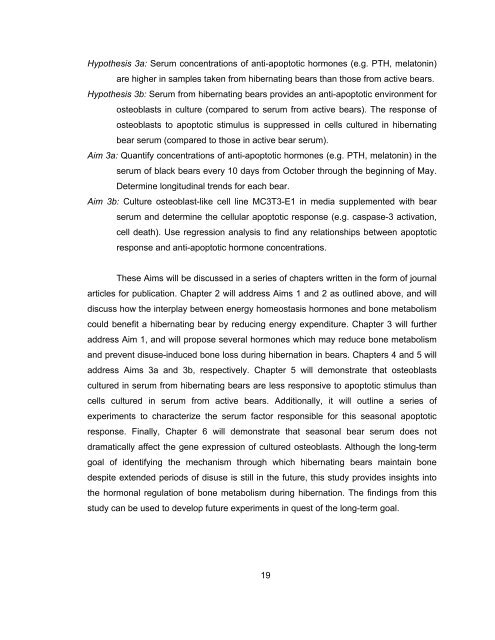C - Michigan Technological University
C - Michigan Technological University
C - Michigan Technological University
- No tags were found...
You also want an ePaper? Increase the reach of your titles
YUMPU automatically turns print PDFs into web optimized ePapers that Google loves.
Hypothesis 3a: Serum concentrations of anti-apoptotic hormones (e.g. PTH, melatonin)are higher in samples taken from hibernating bears than those from active bears.Hypothesis 3b: Serum from hibernating bears provides an anti-apoptotic environment forosteoblasts in culture (compared to serum from active bears). The response ofosteoblasts to apoptotic stimulus is suppressed in cells cultured in hibernatingbear serum (compared to those in active bear serum).Aim 3a: Quantify concentrations of anti-apoptotic hormones (e.g. PTH, melatonin) in theserum of black bears every 10 days from October through the beginning of May.Determine longitudinal trends for each bear.Aim 3b: Culture osteoblast-like cell line MC3T3-E1 in media supplemented with bearserum and determine the cellular apoptotic response (e.g. caspase-3 activation,cell death). Use regression analysis to find any relationships between apoptoticresponse and anti-apoptotic hormone concentrations.These Aims will be discussed in a series of chapters written in the form of journalarticles for publication. Chapter 2 will address Aims 1 and 2 as outlined above, and willdiscuss how the interplay between energy homeostasis hormones and bone metabolismcould benefit a hibernating bear by reducing energy expenditure. Chapter 3 will furtheraddress Aim 1, and will propose several hormones which may reduce bone metabolismand prevent disuse-induced bone loss during hibernation in bears. Chapters 4 and 5 willaddress Aims 3a and 3b, respectively. Chapter 5 will demonstrate that osteoblastscultured in serum from hibernating bears are less responsive to apoptotic stimulus thancells cultured in serum from active bears. Additionally, it will outline a series ofexperiments to characterize the serum factor responsible for this seasonal apoptoticresponse. Finally, Chapter 6 will demonstrate that seasonal bear serum does notdramatically affect the gene expression of cultured osteoblasts. Although the long-termgoal of identifying the mechanism through which hibernating bears maintain bonedespite extended periods of disuse is still in the future, this study provides insights intothe hormonal regulation of bone metabolism during hibernation. The findings from thisstudy can be used to develop future experiments in quest of the long-term goal.19
















